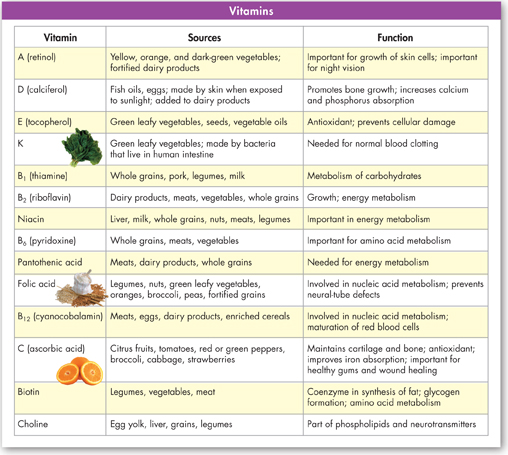Vitamins Organic molecules that the body needs in very small amounts are called vitamins. Most vitamins are needed by the body to help perform chemical reactions. If we think of proteins, fats, and carbohydrates as the building blocks of the body, then vitamins are the tools that help to put them together. As shown in Figure 30–7, most vitamins must be obtained from food. However, the bacteria that live in the large intestine are able to synthesize vitamins K and B12.
There are two types of vitamins: fat-soluble and water-soluble. The fat-soluble vitamins A, D, E, and K can be stored in the fatty tissues of the body. The body can build up small deposits of these vitamins for future use. The water-soluble vitamins, which include vitamin C and the B vitamins, dissolve in water and cannot be stored in the body. Therefore, they should be included in the foods you eat each day.
A diet lacking certain vitamins can have serious health consequences. Eating a variety of foods will supply the daily vitamin needs of most people. Large doses of vitamin supplements do not benefit the body. Excessive amounts of the fat-soluble vitamins A, D, and K can be toxic.

FIGURE 30–7 Vitamins This table lists the food sources and functions of 14 essential vitamins. The fat-soluble vitamins are listed in the first four rows. Interpret Tables What is the function of vitamin K?
dddTable of Contents
- Formulas and Equations
- Applying Formulas and Equations
- Mean, Median, and Mode
- Estimation
- Using Measurements in Calculations
- Effects of Measurement Errors
- Accuracy
- Precision
- Comparing Accuracy and Precision
- Significant Figures
- Calculating With Significant Figures
- Scientific Notation
- Calculating With Scientific Notation
- Dimensional Analysis
- Applying Dimensional Analysis




